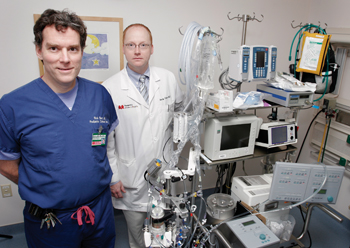
Rick Barr, M.D., Left, and Buddy Creech, M.D., are studying staph infections that are particularly harmful to adolescents. (photo by Kats Barry)
New MRSA form harsher on teens
A new study suggests methicillin-resistant Staphylococcus aureus (MRSA) infections that require the highest level life-support are on the rise, and that a particularly nasty group of the germs found in the community appear to kill about half of the adolescents with the most serious infections.
The study, entitled “Increasing use of extracorporeal life support in methicillin-resistant Staphylococcus aureus sepsis in children” was published in the current issue of the journal Pediatric Critical Care Medicine.
“By all accounts, MRSA looks to be more dangerous, particularly to adolescents, than other staph infections have been in the past. This study reinforces that,” said the study's first author and principal investigator, Buddy Creech, M.D., assistant professor of Pediatrics.
According to Creech, not all MRSA infections are equal. Community acquired MRSA (CA-MRSA) may be more dangerous than the MRSA acquired in hospitals.
The evidence is growing that current strains of CA-MRSA are able to cause more serious illness in healthier people.
“Hospital-acquired MRSA had a reputation as a relatively slow-growing infection that would prolong illness in people with existing chronic infections,” Creech said, “But when you begin to see young healthy people, with no reason to be sick, coming in critically ill with MRSA, that's a red flag that there may be some fundamental changes happening.”
The report, co-authored by, Rick Barr, M.D., associate professor of Pediatrics, Gayle Johnson, R.N., Randall Bartilson, R.N., and Edmund Yang, M.D., assistant professor of Pediatric Surgery, focused on extracorporeal life support (ECLS), which uses a device to artificially oxygenate the blood and assist in circulation when a patient's lungs have failed. The researchers looked at a national registry from the international Extracorporeal Life Support Organization (ELSO).
In the years between 1994 and 2005, 123 children were identified as having Staphylococcus aureus infections leading to respiratory failure and a need to be placed on ECLS. Of those, 45 cases, or 37 percent, were MRSA. The dramatic finding is that 20 of those cases appeared in 2004 and 2005, the last two years of the study.
If that rise in the rate of infections isn't alarming enough, Creech said the rate is still increasing and doctors are seeing too many previously healthy young people dying. “When you compare ECLS deaths from MRSA versus respiratory failure in general, MRSA was 10 percent more fatal.”
The researchers found there is a peak of incidence in infancy and again at age 14 to 15, but the adolescent patients were the most likely to die from their infection, despite the use of ECLS.
Overall survivor of the children with MRSA who were put on ECLS was 49 percent.
“But retrospective studies like this are limited,” Creech said.
“We are not able to see if others in the family experienced similar illnesses, whether patients had previous exposure to CA-MRSA or whether there are individual differences that can predict who will develop life-threatening MRSA disease.”
Researchers say the evidence is clear that CA-MRSA is more virulent and dangerous to healthy young people, so more studies will be a high priority to find out how to be more successful at saving lives and how to prevent the serious illnesses in the first place.
“This will be answered by prospective studies, with patients and their germs linked together.
“We need to be able to look at the organism itself, to find out if there are factors that are exactly tied to higher mortality,” Creech said. “We hope to find solutions soon.”













